Continental to augment reality on your windshield
Automotive parts supplier Continental demonstrated an augmented reality head-up display, showing improved navigation and safety information for future car windshields.
BMW offers a pretty impressive heads-up display (HUD) on its cars, with color graphics projected on the windshield to give navigation and vehicle speed information, but at Nvidia's GTC developer conference, Christian Reinhard demonstrated the next generation of heads-up display, using augmented reality to "paint" information on the road.
Reinhard leads the development of human-machine interaction for Continental subsidiary Elektrobit, and explained the benefits of the new system and when it would come to market.
HUDs was previously a niche area in automotive, but less-expensive enabling technology has let HUDs expand into even lower end cars. Current HUDs typically show vehicle speed and turn-by-turn directions projected onto the lower portion of the windshield, making it easy for drivers to perceive this information without looking away from the road. In most cars, this information is monochrome, and in all cases it is a flat projection.
Augmented reality is a general technology term that implies merging computer-generated graphics with a real world view. In the car, that means projecting information onto the windshield in such a way so that it looks like it is part of the environment.
Continental is close to accomplishing this technological feat using next generation windshield projection technology with a frame rate of 60 fps and high-definition GPS.
Reinhard demonstrated how this augmented reality HUD could be used for a lane departure warning system, for adaptive cruise control and for turn guidance from navigation. In the latter case, the driver a line of arrows that appear to be painted on the road ahead. These arrows point in the direction of the next turn, giving the driver an easy-to-follow graphic correlated to the real world.
Used for adaptive cruise control, the system would highlight the specific car ahead being tracked by the driver's car's sensors, giving confidence that the car is maintaining its speed based on the correct car ahead.
Continental's augmented reality HUD can alert the driver with red indicators on the road if the car is driving over a lane line.
One big challenge to this technology comes from the need to accurately place the car on the map, so the system can correctly show turn guidance or other information. That's why Continental is developing the system using high-definition GPS, which is more accurate than typical GPS today.
More than just a research project, Reinhard explained how HUD technology will increasingly be seen in cars, and that Continental intends to bring this augmented reality version to market. And although HUDs are getting cheaper, and will appear in more cars, Reinhard said that Continental's augmented reality version would likely first appear in high-end luxury cars, where buyers are willing to pay more for options.


